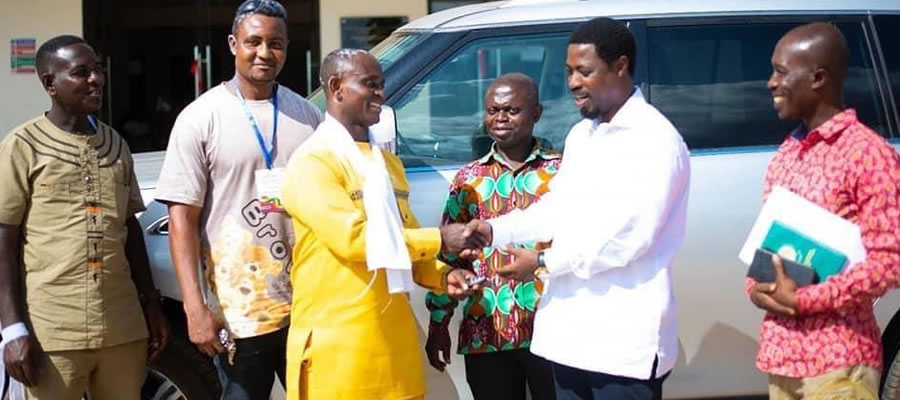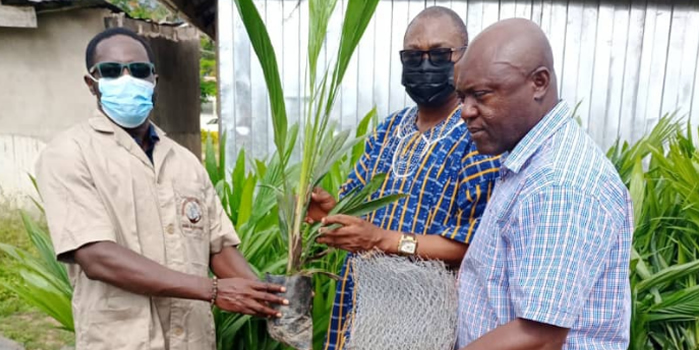

Development planning as a human centred activity seeks to ensure provision of needs of the people. Population analysis is therefore one of the cardinal components, which helps to determine the direction of District Planning Processes in any society. The analysis of the demographic characteristics of the Municipality focuses but limited to population size and growth rate, age and sex distribution, spatial distribution, structure, density, labour force, dependency ratio, etc.
Population Size and Growth Rate
The 2010 Population and Housing Census (PHC) indicated that the Municipality has a population of 123,272 made up of 60,855 males and 62,417 females and a population growth rate of 1.8% as compared to the regional and national growth rates of 2.0% and 2.5% respectively. However, with the assumptions/ factors of population growth including 1.8% growth rate held constant, the Municipality’s projected population as at December, 2016 is 137,084 and is expected to reach 139,532 by December, 2017. Therefore, using the projected population for 2017 as the current population of the Municipality, the males and females population are now 68,929 (49.4%) and 70,603(50.6%) respectively.
Even though the next PHC has not been conducted in the country to get the exact dynamics or changes in the Municipality’s population from 2010 to 2017 and the population for 2018 to 2021, it can be seen from the above projected population of the Municipality from 2010 to 2017 and Table1.9 that the population of the district continues to increase. However, per the inter-censal population in Table 1.9, the female population is increasing at an increasing rate while the male population is increasing at a decreasing rate. Poor attitude towards birth control, high illiteracy level coupled with inadequate knowledge of the implications of keeping large families as well as immigration are some of the contributing factors to this phenomenon.
This increase in population has implications for development planning in the sense that pressure is put on the land size and the existing social amenities in the Municipality. On the contrary, the Municipality stands to benefit from the great pool o f labour associated with the population increase and provides large markets for both goods and services.
The inter-censal growth rates as depicted in Table 1.10 have been on the rise between the various censal periods whereas the population growth rates have been rising for both the Municipality and the national. The pattern is illustrated in Table 1.10. Increase in growth rate could be attributed to the mining activities in the Municipality and other factors discussed above.
From the socio-economic survey conducted, the net migration for the Municipality for a year is 80 (4.2%). The natural increase figure for the Municipality is 15 as against the national figure of 15 (Source: Population Reference Bureau/ Data Finder – Ghana, 2004). The figure being positive has the tendency to cause a steady rise in the population of the Municipality with time.
Age and Sex Distribution
Using the Municipality ’s projected population of 139,532 for 2017 based on the 2010 PHC figure of 123,272 and percentage distribution held constant, the age distribution of the Municipality is skewed towards the age groups of 0-14 (children) and 15-64 (the working age group) as shown in Table 1.11. This implies that the Municipality is endowed with a potential labour force and vibrant youth, which are necessary for any development-oriented society. The Table also indicates the number of males and females in each age group and their percentages respectively.
ISex Composition
Using the Municipality’s projected population of 139,532 and national one of over 27,000,000 for 2017 based on the 2010 PHC figure of 123,272 and percentage distribution held constant, the sex composition of the Municipality is not so much different from that of the nation and the significant thing about the sex composition of the district is that the percentage of the female population is more than the male population as compared to the national population as shown in Table 1.12. Although the sex distribution is almost at par, issues of female participation in local governance, formal education and other decision-making processes remain a challenge to the Bibiani-Anhwiaso-Bekwai Municipal Assembly.
Using the Municipality’s projected population of 139,532 for 2017 based on the 2010 PHC figure of 123,272 and all the factors that influence population change held constant, the structure of the population or population pyramid of the district is illustrated in Figure 1.5 even though with an increase in the population, the structure is expected to change a little.
From Figure 1.5, the working population group is larger than the combined child and aged population of the Municipality. This active age group if given enough capacity building can be an instrument of development to the economy of the Municipality.
Spatial Distribution of Population
The population in the Municipality is not evenly distributed largely due to geophysical and statutory reasons. In the statutory sense, the district has six large forest reserves covering almost 30% or 264 square kilometres of the total surface area that are statutorily protected from human habitation. The population is dispersed in the remaining land. The highest concentrations of people live along the Bibiani-Anhwiaso-Sefwi Bekwai corridor of the Municipality. This phenomenon has implication for provision of educational, health, water and sanitation facilities, housing needs and security concerns. The higher percentage of the population concentrated along the main highway will improve the people access to the District Hospital which is located at the Municipality capital Bibiani on the main highway.
Population Density
The 2010 Population and Housing Census further indicates that, the Municipality has a population density of 141 persons per square kilometre, which is higher than the regional and the national averages of 99.3 and 103 persons per square kilometre respectively. However, with the Municipality’s population expected to increase to 139,532 in 2017, the population density is expected to increase to 159.83 persons per kilometre square. The greater proportion of the available land has been used for cocoa cultivation and a sizeable space of the land surface is under forest reservation, thereby putting pressure on the available land for different purposes.
Therefore, this increase in the density will put pressure on the available natural resources and some of the agricultural lands will be turned into residential uses. Figure1. 6 shows the population density map of the Municipality.
Figure 1. 7: Population Density Map
vi. Rural–Urban Split
The Bibiani-Anhwiaso-Bekwai Municipal is predominantly rural. Using the d Municipality’s projected population of 139,532 for 2017 based on the 2010 PHC figure of 123,272 and all the factors that influence population change held constant, the 2010 PHC indicates that the urban population constitutes 28.5% of the Municipality’s population with 48.3 per cent male and 51.7 per cent female. The rural population also constitutes 71.5% of the population with 49.8 per cent male and 50.2 per cent female. This is a reason based on the fact that most of the people are engaged in agricultural activities hence, the large number of the people in the rural areas. The rural nature of the Municipality coupled with scattered settlements, poses serious development challenge with regard to distribution and provision of basic services to the people.
vii. Dependency Ratio
The dependency ratio is a measure of the dependent population made up of those below 15 years and 65 years and older, to those in the “economically productive” ages of 15-64 years. This ratio is used to measure the pressure or burden borne by those in the “economically productive” ages. The Municipality dependency ratio is 79.56 per cent according the 2010 PHC. This implies that almost 80 persons are being supported by 100 persons in the working ages (15-64 years).The assumption is that everyone within the age group 15-64 years is working or earning an income which is normally not the case. Generally, the dependency ratio is also higher in rural (58.5%) than the urban which is (41.5%).
While considering the fact that a large proportion of persons aged 15-64 is either unemployed or not economically active, it should also be noted the actual burden on the employed in the Municipality would also be more serious, leading to a low standard of living. A high dependency ratio indicates that the economically active population and the overall economy face a greater burden to support and provide the social services needed by children and by older persons who are often economically dependent. This is very evident in the Municipality with its rural areas having a ratio of 83.20 as against 71.03 in the urban areas. The need to ensure access to basic services, such as education and health, therefore has to be emphasized to ensure the economic security of children and older persons.
Migration A survey conducted in the Municipality in 2005 indicated that the in-migrant was 161 people constituting 8.5 % of the sample population out of which 75 (4%) were from the communities within the Municipality and 86 (4.5) were from outside the Municipality. The out-migrant constituted 4.3% and the in-migrant represented 8.5% in the Municipality. The net migration which is the difference between the out- migrant and the in- migrant is then calculated to be 4.2%.
A net migration of 4.2% gives an indication that; in-migration outweighs out-migration and can be attributed to the following reasons:
i. That the Municipality is one of the dominant areas in the country noted for cocoa cultivation and as such people locate themselves there to engage in this farming activity.
ii. Again the area is much endowed with mineral resources and these also attract people to the Municipality. However, the situation if not controlled can adversely affect the existing social amenities in the Municipality and other social vices that always associated with migration.
Gender
Gender is a social construct specifying the socially and culturally prescribed roles that men and women as well as boys and girls are to follow. According to the 2010 Population and Housing Census, males constitute 49.4% and females 50.6% of the total population of 123,272 in the Municipality. However, using the projected population for 2017 based on 2010 PHC as the current population of the Municipality, the males and females population are now 68,929 (49.4%) and 70,603(50.6%) respectively. This is not in sharp contrast to the national population where males and females constitute 48.8% and 51.2% respectively.
As the society is moving predominantly towards a market economy, money has become the main currency. In view of this, the number of mothers entering the labour force is increasing every year and mush more mothers with pre-school children is increasing. Since women are forced into the labour market, the gender roles have changed considerably. Women contribution in the family budget have made men somewhat changed their attitude and help with domestic chores. The invisible work of women still remains the same and is largely unrecognised and undervalued.
In terms of education, the number of boys is quite higher than girls. Boys in school continue to perform better than girls. In the 2014 BECE, 1,335 boys passed representing 46.59% whilst 1,090 girls representing 37.86% passed. There is therefore the need for the major stakeholders to put in place interventions that will help the girl-child to improve her performance. Most girls who complete their basic education but are unable to further their education are engaged as apprentices in hairdressing and dressmaking. Others are engaged in petty trading.
In decision making, the participation of women continues to be marginal. For instance, at the last General Assembly composition, out of a total of 52 member general assembly, only 7 were females representing 13.46%. For further details, the situation is very serious because out of the 36 elected Assembly members, only 1 elected female member in Electoral Area as compared to the current General Assembly with the same composition having only 4 females representing 8% with only 1 elected female member in Lineso Electoral Area.
There are many sub-committees without female representation as well as the unit committee levels in the local communities. The voice of women are therefore not heard at the highest decision making body in the Municipality. There is only one female who is the head of a decentralised department. All the other heads of departments are males. In the Central Administration, all the female employees with the exception of one are all junior staff. There is therefore the need for feminist advocacy groups to intensify their campaigns on women empowerment.
In terms of power, men possess more power than women and as such men control greater proportion of the economic resources like cocoa farms, arable land, income, etc. Differences in power between men and women are institutionalised by culture and are expressed in the everyday relations of men and women particularly in families. Further, many women deliberately make an effort to protect their masculinity by working to appear that their husbands are in control. In the Municipality, about 76% of the working population are farmers-either full time or part time.
The implication of the gender disparity against women at all level in the Municipality continues to negatively affect their welfare and total development in the Municipality. The Municipality must take affirmative actions to bridge the gap between men and women, boys and girls if not equal levels, but close to ensure equal participation and balance development as well as mainstreaming gender issues in the development processes and fight discrimination.
Settlement Systems
Settlement systems or spatial analysis deals with the nature of distribution of settlements and their functions in the space economy. This affects accessibility to basic services, employment opportunities, size and distribution of incomes and other developmental issues. This shows the importance of spatial organisation of population, settlement patterns, services, surface accessibilities, and commodity in the planning of developmental policies and programmes for the Municipality.
Settlement Pattern
With the present population density of 160 persons per square kilometre per the Municipality’s projected population for 2017 based on the 2010 PHC, the Municipality is not all that sparsely populated as compared with the regional average of 99.3 persons per square kilometre. There are at least 345 communities with about 65 having a population above 500 persons (2010 Population and Housing Census) making the Municipality predominately rural. This shows that majority of the inhabitants live in isolated hamlets and cottages preferably on their farms. Thus, the general settlement pattern of the Municipality can best be described as dispersed type. This dispersed settlement pattern makes it difficult to provide essential social services to most people in the Municipality.
Scalogram Analysis and Hierarchy of Settlements
The scalogram shows how the facilities and services are distributed in the settlements in the Municipality. The distribution of facilities and services in the Bibiani-Anhwiaso-Bekwai Municipal as indicated in Table 1.13 depends on the type and level of services and to some extent on the population of the settlements. It is important to note that the population figures for the selected 16 major settlement in the scalogram are based on the 2010 PHC. Services like schools, health centre, boreholes, market, sanitation facilities, electricity and extension services are located in most settlements. Other major towns such as Bibiani, Bekwai, Chirano, Anhwiaso, Awaso, etc. have high level services such as hospital, health centres, pipe water, police headquarters, circuit court and senior secondary school.
All settlements in the scalogram have primary schools, Junior High Schools (JHS), Boreholes and Electricity and Agricultural Extension services. Nine out of the 16 settlements have pipe water, 14 have access to mobile telecommunication services and eight have public toilets whiles only five have community library/ICT. Besides, three have health centres of which are operational, seven have CHPS Compound, three have private clinics and three have periodic/weekly markets etc. Bibiani, the Municipality capital has government hospital while Awaso and Bekwai have private hospitals belonging to Ghana Buaxite Company and private individuals respectively. The four SHS are located at Bibiani, Bekwai, Chirano and Anhwiaso.
There is inequality in the spatial distribution of facilities and services in favour of settlements along the main highway stretching from Bibiani through Anhwiaso, Awaso to Bekwai, where main commercial and industrial activities are concentrated. These main routes fall within the high population density areas of the Municipality. However, Chirano, Subri and Humjibre which are outside the main route have some level of more services such as SHS, health centre and clinic respectively. One significant feature of this scalogram is that Akaaso which population is bigger than Ankra Muano, the settlement with the least population among the 16 major settlements has the least facilities in the Municipality.
Using Table 1.12, which shows the scale of centrality index indicating the hierarchy of settlements, we have Bibiani and Bekwai as the Level 1 settlements which is the status as in last four years i.e. 2014-2017 DMTDP. The Municipality has only one settlement as Level 2 whilst Levels 3 and 4 have four and nine settlements respectively. This means that most important facilities and services in the Municipality are concentrated only in about three communities particularly Bibiani the Municipality capital, Bekwai and Awaso.
The above analysis indicates that there is the need to provide more services and facilities such as feeder roads, postal services, CHPS Compound and clinics, markets and public toilets to the deprived communities to ensure equity in development of the Municipality. There are deplorable feeder roads which calls for collaborative and pragmatic efforts between the Assembly and its development partners to improve the bad feeder roads network in the Municipality.
Surface Accessibility to Services
The surface accessibility is the ease with which one travels/moves from a given location to another location (s) within the Municipality in order to access a given/available facility (s) or service (s). This is measured in terms of the time spent in travelling between the two locations (travel time), which in turn depends on distance, means of transport and the route conditions.
The general accessibility to facilities or services particularly hospital, health centres, secondary school, weekly markets, banks, courts, extension services in the Municipality can be described as good. This is because the BAB Municipal is one of the districts in the country which has one good highway but poor conditions of feeder roads as a result of heavy rainfall and untarred nature of the roads.
The main facilities or services are located in the communities along the main road corridor from Nzema Nkwanta- Bibiani -Anhwiaso and Sefwi Bekwai particularly Bibiani, the Municipal capital. The people living along the main highway which can be said to be in a high access zone whiles those living outside the main highway and feeder roads are in low access zones in the Municipality.
For instance, the acceptable maximum/standard time for accessing facilities like hospital, health centres, weekly market, bank, and Agriculture extension station is 30mins, 20mins, 30mins, 30mins and 20mins respectively. The implications of the generally good surface accessibility in the Municipality are that, the people are not prevented from accessing the facilities or services to benefit fully to improve their incomes and health. It can also contribute to high productivity and production in the Municipality. Trading activities in the district are usually enhanced as distribution and marketing of goods and services both within and outside the Municipality go on well. The map below or Figure 1.8 indicates the transportation network and surface accessibility of the Municipality.
Figure 1.8: Transportation Map
Source: BABDA, 2017
Housing
The 2010 Ghana Population and Housing Census is the second national census, following the 2000 census, which included a comprehensive housing census. The two censuses provided an official count of all structures (permanent and temporary) within the nation. Among the issues covered were the number of occupied and unoccupied dwelling units, the type of dwelling and the main materials used in construction, occupancy status, and methods of waste disposal, utilities and household facilities. It is envisaged that the housing data from the 2010 PHC will enable planners and policy makers formulate realistic and relevant housing policies and design appropriate programmes to meet Ghana’s housing needs.
Housing Stock
There is often a relationship between socio-economic conditions of households and the quality of life of their members. As a unit for production and consumption of resources, the characteristics of a household such as size, composition, and economic base, have implications for aspects such as health, productivity, social interaction, welfare, security and general outlook. According to 2010 Population and Housing Census there were a total of 18,540 houses in the district with urban forming 26.1 per cent and rural constituting 73.9 per cent. The data also show that there are 27,961 households made up of 30.2 per cent in urban and 69.8 per cent in the rural areas in the Municipality.
Bibiani Anhwiaso Bekwai is a Municipality with an average household size of 4.3 persons with the rural recording a slightly higher number of 4.4 persons and urban (4.0). Population per house in the Municipality is also 6.5, with 7.0 persons in the urban and 6.3 persons in the rural areas.
Type of Dwelling, Holding and Tenancy Arrangements
The total population owning houses in the Municipality is 27,961 constituting about 5 per cent of the regional population owning houses. Among the various categories of ownership status, male headed households owning houses (67.3%) supersedes female headed households owning houses in the Municipality (32.7%). Houses owned by a household member constitute about 58 per cent of the total number of houses in the Municipality and is followed by houses owned by relative not a household member (19%) and other private individual (18.1%).
The population owning houses in the rural areas (69.8%) is higher than the urban population (30.2%) owning houses. In respect of houses owned by other private individual, majority of the population in urban centres of the Municipality occupy houses which belongs to other people than in the rural communities of the Municipality with their figures given as (58.1%) and (48.1%) respectively. However houses owned by relative not a household member are highly occupied in the rural (73.0%) than urban (27%) areas in the Municipality.
Occupied dwelling
The type of dwelling unit occupied by households in the Municipality is such that over one-half (53.9%) of all dwelling units are compound houses making it the most common type of dwelling unit in the Municipality. Separate houses account for 32.0 per cent of dwelling units in the Municipality. Living in semi-detached houses and flats or apartments is not common among resident or households in the district. Only 9.5 per cent live in semi-detached houses and 2.8 per cent dwell in flats or apartments.
Construction Materials
The main materials used by households for the construction of dwelling unit are mud brick/ earth in the rural areas (51.4%) compared to 20.3 per cent in the urban areas. In contrast, 40.7 per cent of rural households live in buildings constructed mainly with Cement blocks/Concrete whereas those in the urban areas constitute 72.4 per cent. Also, 2.0 per cent of households in the rural areas in the Municipality use burnt bricks as material for the construction of dwellings whilst that in the urban areas constitute 3.1 per cent of household.
However, less than 2.0 per cent of dwelling units in the Municipality are constructed of wood, stone, landcrete, bamboo, palm leaf/ thatch (grass)/ raffia and other materials for the outer wall of dwellings. It also indicated by 2010 PHC that cement/ concrete (87.4%) is the main construction material used in the district. The pattern is the same for construction material for the floor in both urban (88.9%) and rural (86.8).
(86.8). In the case of main material for roofing, the 2010 PHC shows that 92.6 per cent of dwelling units are roofed with metal sheets. This has 91.7 per cent in the urban areas and 92.9 per cent in the rural areas.
In the urban areas, percentages of houses roofed with thatch and slate/ asbestos constitutes 1.6 per cent and 3.2 per cent respectively. Thatched and slate/ asbestos constitute 2.2 per cent and 0.8 per cent of roofing materials used in the rural areas.
Mud/Mud bricks/Earth, Wood, Cement/Concrete, Roofing tile, Bamboo and other roofing materials form a percentage below 1 per cent of materials used for roofing and the use of cement or concrete accounts for only 0.8per cent in the Municipality.
Room Occupancy
The relationship between the number of rooms and the number of persons gives the space available per person. According to 2010 PHC, 58.9 per cent of households in the Municipality occupy one room. As little over 22 per cent of households occupy two rooms and 9.1 per cent occupy three rooms. Households that occupy four rooms or more together constitute 8.3 per cent. On the part of those who occupy single room, a single member alone constitutes 89.9 per cent. It is quite significant in cases where three or more persons live in one room ranging between 8.5 per cent for ten or more person and 67.9 per cent for three persons.
Access to Utilities and Household facilities
The quality of life of persons depends, among other factors, upon the amenities and assets available to them. Though remarkable achievements have been made in extending basic amenities to the people in the district, there are still large areas of deprivation, which requires urgent attention. Electricity as the source of lighting is available to 72.0 per cent households. This is followed by Kerosene lamp (13.4%) and Flashlight/Torch (13.0%).
Date Created : 5/3/2023 12:00:00 AM













 facebook
facebook
 twitter
twitter
 Youtube
Youtube
 +233 593 831 280
+233 593 831 280 0800 430 430
0800 430 430 GPS: GE-231-4383
GPS: GE-231-4383 info@ghanadistricts.com
info@ghanadistricts.com Box GP1044, Accra, Ghana
Box GP1044, Accra, Ghana